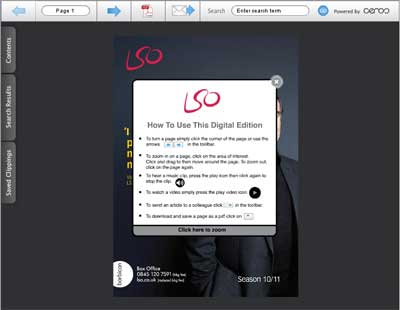David, Corwin and Amelia report out on Day One of the 2010 National Arts Marketing Project Conference. Items discussed: keynote by Chip Heath, breakout sessions (pros and cons), designing conferences for people with varied experience levels, social media rock stars, and more.
On the Way to San Jose & NAMP 2010
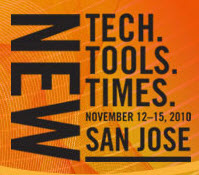 Corwin, Amelia and I are heading out to San Jose for the National Arts Marketing Project (NAMP) Conference this weekend.
In addition to presenting a panel on using performance video to motivate audiences and leading roundtables on Twitter and search engine optimization (SEO), we will be interviewing various presenters and arts marketing superstars for upcoming podcast episodes.
Corwin, Amelia and I are heading out to San Jose for the National Arts Marketing Project (NAMP) Conference this weekend.
In addition to presenting a panel on using performance video to motivate audiences and leading roundtables on Twitter and search engine optimization (SEO), we will be interviewing various presenters and arts marketing superstars for upcoming podcast episodes.
We will also be chatting with conference attendees to find out what useful information and experiences they will be acting upon when they go home.
If there are particular people whom you would like us to interview or particular questions you would like us to ask conference participants, then drop a note in the comments area below.
If you are on Twitter, you can read our thoughts about the conference by following TechInTheArts. You can also follow the #NAMPC10 hashtag on Twitter to read the chats taking place during the conference.
Stay tuned for more from NAMP 2010 in San Jose!
What you need to know about viral video and the law
![]() Technology in the Arts has just released a publication reviewing legal issues surrounding using video footage online. (Access the PDF publication here.)
Whether you are in marketing, development, education or operations, chances are that you will encounter some kind of contract or legal issue involving performance footage, either online or offline. This white paper serves as a survey of current industry trends and practices, as well as a guide to those exploring the ever-changing landscape of online media and the intellectual property and union issues associated with it. While nothing can replace the advice of a good lawyer on legal issues, this guide can alert you to potential problems while you are planning online media campaigns involving performance footage.
Technology in the Arts has just released a publication reviewing legal issues surrounding using video footage online. (Access the PDF publication here.)
Whether you are in marketing, development, education or operations, chances are that you will encounter some kind of contract or legal issue involving performance footage, either online or offline. This white paper serves as a survey of current industry trends and practices, as well as a guide to those exploring the ever-changing landscape of online media and the intellectual property and union issues associated with it. While nothing can replace the advice of a good lawyer on legal issues, this guide can alert you to potential problems while you are planning online media campaigns involving performance footage.
Do you have a story about issues you've had distributing performance footage online? Please share below.
Focus on the data: LSO's Digital Season Brochure
Last year I wrote about the London Symphony Orchestra’s digital season brochure. As technology and environmental concerns cause more printed pieces to go online, the arts industry will see more season brochures go digital. According to a recent Technology in the Arts poll, 56% of arts organizations already have their season brochure online in some form (PDF or interactive).
Last season was the first that they made the brochure, launching it in February of 2009 with their season announcement. Based on its success, they have released another brochure this year with plans to distribute it more widely. Today I have a follow-up with Digital Marketing Manager Jo Johnson about the success of last year’s brochure.
The marketing team at the London Symphony Orchestra chose to make last year’s season brochure after deciding to plan the online and offline elements of our season campaign together. Jo said, “we had produced films to illustrate the season's themes, but it was a few months after the season had first gone on sale, and so felt rather like an afterthought. Also we had decided that we were going to put our season on sale online before we opened to telephone booking, so turning to online channels (email, web and social networks) to send info out to the bookers felt natural. A digital brochure was the obvious choice.”
For newcomers to the digital brochure, it may be hard to know where to get the technology to make the brochure, as well as how much lead time to allow for it. This year symphony again used interactive publication platform Ceros to create their season brochure, complete with audio and video. Other platforms that were suggested in our poll included Issuu and Yudu.
According to Jo, after the art and copy was approved for the print brochure, the digital brochure only took about two additional weeks. “[The print version] needs to be made suitable for online readers (adding some buttons, changing some bits of text to make it obvious that their links, making the images 16:9 ratio so that you can embed a video over it). That's about a week. Then because I don't have Flash skills, the digital brochure company did all the Flash work for me. They were pretty quick, but leave time for changes, testing and sign off. That was about another week.”
Jo found that the brochure was driving traffic primarily to concert pages (where tickets can be purchased). “The top 20 clicked links are all to concerts, with the season opening concert on 20 September being the most clicked.” Using Google Analytics, Jo determined that roughly 1 in 5 viewers played a video, and viewing figures correspond to page numbers (i.e. the least viewed video is last in the brochure). Viewers stayed on the digital season brochure an average of about four minutes. Overall, the 2009/10 digital brochure was viewed 10,870 times. Based on the data she pulled she concluded that the amount of revenue directly from the brochure covered its costs, but that the brochure “played a more of a role in decision making than direct purchasing." She said:
On the financial side, I could see purchases made on our website that had come directly from the digital brochure. Added up, the income was just over the figure it cost to make the brochure. But as with all marketing, I'm also interested in the purchases that were made as a result of someone having the digital brochure, but not directly. At the LSO we talk about multi-channel marketing and CRM, whereby we allow the customer to make his own decision on which method to use to make the final purchase. So although the brochure had embedded links back to the LSO website where tickets can be bought, a customer may have browsed the brochure, seen a concert they like, gone away to chat to a friend about going together, made a decision a week later, and then gone back directly to the website to make the purchase, or called the box office on the phone. In this case I would not have seen the income from his ticket in the analysis I did on the brochure; and this is what I meant when I said 'It's likely it plays more of a role in decision making than direct purchasing.'
When taking on these technological innovations, it’s difficult to know how to measure success. As Jo said in our conversation, “This is the challenge marketers face every day--how to track customers as they hop through our available channels.” Your outreach program or social media site may have paid for itself in tickets, but how do we measure things like brand recognition? Social marketing experts like Charlene Li and David Berkowitz have come out with suggestions, some of which go beyond mere revenue. Jo saw two huge benefits to producing the brochure, beyond its break-even point.
The very fact that we had produced one at all gave the LSO a huge amount of coverage. It was passed around as a 'novelty' item, which people enjoyed looking at, turning the pages, watching the videos, just to see what it did. This is the same kind of benefit as social media brings an organization--people talking about your group. They might be on the other side of the world, they might not come and buy a ticket, but the fact that you have come to their attention is almost as valuable as a ticket sale - in our case it may eventually assist in ticket sales when we go on tour, or on sales of our CDs (our own label). Unfortunately, the "buzz" isn't really trackable in any meaningful sense, other than clicks and views and Retweets. But it still counts.
Lastly, the digital brochure brought a small environmental benefit. We reduced the number of brochures we printed, since we sent it out to people on our database that had email addresses instead of the print in the post. We also used the digital brochure in the information we emailed out to journalists at the season launch, instead of posting them one. Our Managing Director likes to email the digital brochure to prospective festivals and venues abroad as our "flagship" publications, thus saving more paper and postage. I'm sure the effects are negligible in the bigger picture, but any boost to our green credentials helps!
So, is investing time and money worth it for your company? Here are Jo’s thoughts:
Probably the most useful thing I can offer is some thoughts into whether others should follow suit and produce a digital brochure. Here's some:
- A digital brochure should never replace your printed one, but should be complementary to it. A good marketing campaign should have all the online and offline elements planned in together at the same time.
- Personally I think the key to it is to have good content which makes it worthwhile - video content is the obvious one. There are plenty of free options for making a digital brochure out of your PDF, but mostly these don't offer the rich media content like embedded videos and soundclips.
- Make sure you have the mechanisms and a plan in place to market the digital brochure - which can only really be done online. Social networks are ideal, but don't ignore your own website! There's no point in having one if you don't market it - people will not stumble upon it randomly.
- Ideally the digital brochure should be designed with online usage in mind - and possibly independently from the print version. We weren't able to do this wholesale though because of the cost of the designers! We chose the route of adapting the printed version.
Are You Getting the Most Out of Twitter? - November Webinar
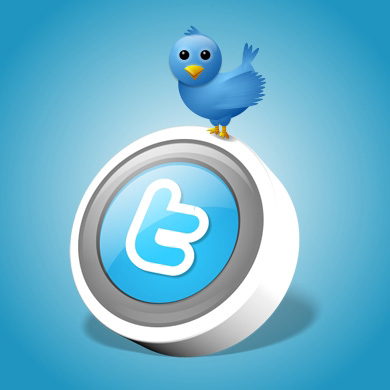 Getting the Most Out of Twitter
Getting the Most Out of Twitter
Thursday, November 18, 2010 2:00pm-3:30pm Eastern Register today for $25 Presenter: David Dombrosky
As the ninth most popular website in the world, Twitter has quickly grown into a formidable communications platform. But what can you really do with 140 characters or less? How can arts managers make the most of this increasingly useful tool?
In this webinar, you'll learn:
- Who uses Twitter, and why they want to engage your organization.
- What aspects of Twitter distinguish it from other social sites, how your organization can use these aspects to communicate more effectively.
- The 70-20-10 rule for engagement, and how you can use it to your advantage.
- Best practices for arts organizations using Twitter
- What third party applications can arts managers use to share media, expand your reach, and much more.
- What analytic tools exist to help you chart your Twitter success
 David Dombrosky is the Executive Director of the Center for Arts Management and Technology (CAMT), an applied research center at Carnegie Mellon University investigating ways in which arts organizations can use online technology to more effectively meet their goals. He frequently presents technology and social media workshops for arts conferences – most recently for The Association of American Cultures, Performing Arts Exchange, Chorus America, Opera America, College Art Association, and Grantmakers in the Arts.
David Dombrosky is the Executive Director of the Center for Arts Management and Technology (CAMT), an applied research center at Carnegie Mellon University investigating ways in which arts organizations can use online technology to more effectively meet their goals. He frequently presents technology and social media workshops for arts conferences – most recently for The Association of American Cultures, Performing Arts Exchange, Chorus America, Opera America, College Art Association, and Grantmakers in the Arts.
True Personalization: Don't Get Filtered
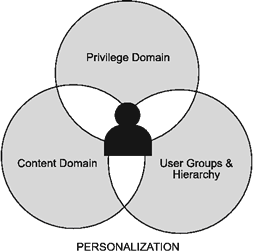 Researchers from Georgia Tech University recently published their first annual Future Media Outlook, an interactive online publication through nxtbook. Future Media Outlook tackles the concepts of information, technology and media in the future by focusing on "the trends that will fundamentally transform how content is created, distributed, and consumed..."
The publication focuses on six main concepts, one of which (arguably the most interesting) is true personalization - the ability to manipulate, personalize and filter a personal data stream. These manipulations change the information that is available or presented to a person based upon their previous actions and settings. True personalization will affect our consumption of products and services as well as how we spend our ever shortening leisure time. The click of a button or the modification of a setting could alter advertising, attendance, and data distribution for companies and organizations in incredible ways.
Researchers from Georgia Tech University recently published their first annual Future Media Outlook, an interactive online publication through nxtbook. Future Media Outlook tackles the concepts of information, technology and media in the future by focusing on "the trends that will fundamentally transform how content is created, distributed, and consumed..."
The publication focuses on six main concepts, one of which (arguably the most interesting) is true personalization - the ability to manipulate, personalize and filter a personal data stream. These manipulations change the information that is available or presented to a person based upon their previous actions and settings. True personalization will affect our consumption of products and services as well as how we spend our ever shortening leisure time. The click of a button or the modification of a setting could alter advertising, attendance, and data distribution for companies and organizations in incredible ways.
Due to the Data Tsunami created by the vast amount of information in this projected future, personalization will be required to focus content and allow people to navigate their own networks. Recommendation engines that compile our habits with our preferences will tailor our shopping, leisure and social experiences. People will know what events are going on, what food is being served, where meetings are happening, and where they most likely want to be at the touch of a screen. While this technology will show them exactly what they want to see, it begs the question : will they care about the information they are not receiving?
 For arts organizations, this could lead to new levels of advertising, event management and customer service, but it will also require new levels of tech savvy and strategic media planning. Data is powerful and no organization wants to be on the wrong side of a filter.
For arts organizations, this could lead to new levels of advertising, event management and customer service, but it will also require new levels of tech savvy and strategic media planning. Data is powerful and no organization wants to be on the wrong side of a filter.
Personalized recommendations, advertising, and marketing have already been implemented on sites like Google, Groupon, and Facebook. An individual's habits and data input affect the advertisements presented to them and the ways in which services are provided. In the future, this technology will become even more sophisticated and less conspicuous. The digital wave of news and information will manifest itself in total customization and intuitively targeted marketing.
Data input and manipulation could become a new burden for many institutions. In a world of customized lives and filtered data experiences, the arts will need to create their own space, partner with other industries and stake a claim in the entertainment and cultural markets. Being able to track events by location, recommend performances from purchasing habits and cultivate new donors from restaurant choices are wonderful concepts that could arise from this technology, but they will need to be created and managed by the arts institutions themselves.
A world with true personalization focuses on providing services to fill a customer’s needs. Having a clear understanding of the market, the service being provided and the correlations that must be made will be integral to navigating a world of filters and preferences. This new world of data will be based on research, correlations and the value of time and information.
Georgia Tech does a compelling job at forecasting the current trends and focusing on where technology is leading us. This trend is real, and I believe it will manifest itself in the not-so-distant future. A world where patrons require automatically updated calendars, events and performances synced with their Google calendars, and interactive donor plans is just around the corner. Recommendation engines, geolocation-based event maps and social event feeds are quickly moving from the future to the present. It will be interesting to see if these predictions become reality and how the arts and cultural sector reacts to this new world of filters and data.
Social Media Spotlight: New York Theatre Network
Welcome to the second installment of the Social Media Spotlight, our monthly feature focusing on arts organizations’ social media strategies.
NYTN Logo
The global trend of participation in social networks and social media is one to which arts managers have been paying a great deal of attention. With over 500 million active Facebook users, 55 million tweets being sent per day and over 133 million active bloggers in the United States alone, arts organizations and arts managers are growing increasingly interested in identifying ways to engage their audiences and connect to new audiences via social media.
One of the more recent example of the intersection of social media and audience development is the creation of the New York Theatre Network (NYTN). Launched on September 28, NYTN seeks to be “your hub for what’s happening on New York City Stages”. The network focuses specifically on theatre events in New York City, and while any theatre fan can check out the latest happenings, only member theatres are able to upload content about their organization onto the website.
NYTN is unique in that it was designed to be an interactive social network as opposed to a static directory and listing of information. Its Facebook Connect feature enables users to find out what their friends are ‘liking’, ‘attending’ and/or ‘recommending’ and also allows users to make their own recommendations.
NYTN1
Theatres are also encouraged to interact with audiences as they are able to upload YouTube videos, their Twitter stream, blog posts and an event calendar onto their pages. A gracious sponsorship from Flip Video’s Spotlight For Good Program made it possible for member theatres to record video and upload this content onto their page.
NYTN2
NYTN is the result of a cooperative effort between The Alliance of Resident Theatres/ New York and theatre industry website Theater Mania. A.R.T. New York Executive Director Virginia Louloudes was inspired by a keynote speech delivered by Diane Ragsdale of the Andrew Mellon Foundation two years ago in which she addressed the decline in arts participation and examined possible solutions for this dilemma. One suggestion was for arts organizations to consider becoming “arts concierges” and help consumers find shows and performances based on their individual tastes.
Louloudes saw an opportunity to create a site that would serve as a “one stop shop” for theatre fans, encourage a new level of interaction between theatres and audiences, and introduce fans to new theatres and upcoming shows they may not have been aware of. The project was an extensive one and called for outside funding, workshops with member theatres, and a partnership with Theater Mania for technological support. While such an ambitious project may not be feasible for all arts organizations, Louloudes hopes that the creation of NYTN will encourage arts managers to develop their own social media strategies, especially since most platforms are free.
Those interested in further reading on NYTN's marketing efforts should also consult the following blog articles from Devon Smith, who served as project manager for NYTN and frequently blogs about social media:
Are You Making the 5 Biggest Facebook Mistakes?
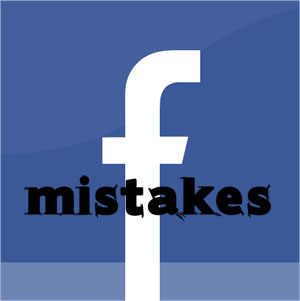 In preparation for next week's webinar How to Make the Most of Your Facebook Page, I asked Maryann Devine from smArts & Culture and Jacquelyn Kittredge from e-bakery social media to share with us the 5 biggest mistakes that arts organizations make on Facebook. Here is their reply:
1. Using Facebook as a broadcast channel rather than interacting with your fans. If your aim is to become invisible to your fans, this is the way to go. Facebook determines where you show up in your fans' default Top News stream based on the interactions of the fans and their friends with your page, and the kind of content you put up. Less interaction means your page is less visible to your fans -- the very people you want to reach.
In preparation for next week's webinar How to Make the Most of Your Facebook Page, I asked Maryann Devine from smArts & Culture and Jacquelyn Kittredge from e-bakery social media to share with us the 5 biggest mistakes that arts organizations make on Facebook. Here is their reply:
1. Using Facebook as a broadcast channel rather than interacting with your fans. If your aim is to become invisible to your fans, this is the way to go. Facebook determines where you show up in your fans' default Top News stream based on the interactions of the fans and their friends with your page, and the kind of content you put up. Less interaction means your page is less visible to your fans -- the very people you want to reach.
2. Using the same voice on Facebook (and other social media) as you do in your traditional marketing. Many arts managers have trouble making that leap, and it's understandable. They're used to communicating with their patrons in a particular style -- it's hard to shake that off. The reality is that using the same voice on Facebook as you do in your ad copy is just not going to work, and you'll likely be ignored. Social media spaces are more personal, like a backyard barbeque or the kitchen table, and you need to adjust your tone accordingly.
3. Forgetting that the page is for your fans, not for your organization. As Jacquelyn often points out, fan pages harken back to fan clubs. Fan clubs were all about giving special access and fan-club-only perks to the most loyal enthusiasts. Research shows that most people 'like' Facebook pages for discounts and special offers. Keep that in mind as your interacting with your group's fans.
4. Creating a personal profile or group for your arts organization rather than a fan page. Fan pages allow you to analyze stats on how people interact with your page AND the demographics of your fans. Personal profiles and groups can't do that. Fan pages can have an unlimited number of fans. Personal profiles are limited to 5,000 friends. Most importantly, Facebook is indexed by Google and your page can improve your Google ranking -- it may be easier to find your fan page through Google than your own web site.
5. Not having a Facebook Page at all because you already have a website. People are spending more time on social networks and less time on static websites, so Facebook allows you to meet your fans where they are already are.
In addition to addressing these common mistakes, Maryann and Jacquelyn's webinar will discuss:
The webinar is on Tuesday, October 19th from 2pm-3:30pm EST. Registration is $25. Click here to register today.
What should we adopt? How can we adapt?
This post also appears as part of the Arts Marketing Blog Salon hosted by Americans for the Arts.
While reading over the Arts Marketing Blog Salon entries this week, particularly David’s entry on the rise of the citizen critic and Ron Evans’ post on online reviews, I was reminded of an experience I had a few years ago when our local paper cut its classical music and dance critic. I had a meeting with many of the marketing directors in the city, who were understandably upset about the firing and convinced that their success was inextricably linked with newspaper coverage.

- Should we adapt to new technology before we adopt it for our own uses?

Many of these people had been in marketing for 30 years. When they first started out in the business, the primary marketing channels were TV, radio, and newspaper (and maybe billboard, telemarketing, or fax.) When a new medium was introduced, it might take a while to master, but that was fine. The learning curve was viewed as an investment because you knew that medium would still be around in five years.
Compare that to now. We have new, “must-have” technology platforms coming out nearly every 6 months to a year. Today, we are being pushed toward mobile apps for phones and iPads, geolocation social media like Foursquare, and more. We are not sure if these technologies will still be popular in three months, let alone five years down the road. Combined with the slow-but-steady demise of many of the “classic” marketing channels, it leaves us constantly wondering: how quickly should we adapt and adopt, when it comes to new technology?
Specifically relating to citizen critics, these two issues come head-to-head. Firstly, we have the citizen critics adopting new media platforms for distributing their reviews. Then, we as arts managers must decide if and how we will adapt to them—ignore them, embrace them, meet them on their own turf with a social media friendly press release, etc.? How do we decide?
When I studied communications technology in undergrad, one of the first things we talked about was Moore’s Law, the principle that the capacity of new technologies doubles every 18 months to two years. It applies not only to the memory size on a new laptop or the number of pixels in digital cameras, but it also describes the exponential rate of change we are experiencing as a society. I find myself thinking about this principle every time I hear that arts organizations “should be using” this new platform or that new tool.
Even though the capacity of the technology may have increased or the new platform may have reached critical mass in usage, my workload capacity typically has not increased nor has my motivation to take on one more task reached critical mass! Chloe Veltman’s post does a wonderful job in relating this back to arts managers, speaking to both a difficulty in adapting to the demands of social media (particularly Twitter) as well as a resistance towards adopting it as part of audience engagement.
So, typical of this age in which we are often left with more questions than answers, I leave you with two questions to mull over when planning your marketing strategy: What are the signifiers that it is time for your organization to adapt to a new technology? Which signifiers indicate that your organization should adopt the use of a new technology?
Going Mobile - Websites vs Apps
This post also appears as part of the Arts Marketing Blog Salon hosted by Americans for the Arts.
During last week's Arts Marketing Blog Salon, Mary Trudel advocated connecting with audiences via mobile technology. CTIA, the international association for the wireless telecommunications industry, recently revealed that mobile phone market penetration in the United States reached 93% for the nation’s total population in June 2010. With usage numbers like that, there is no doubt that arts organizations should be investing in mobile engagement.
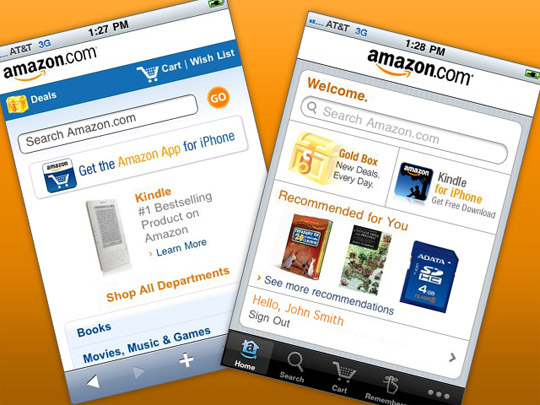
- Amazon can afford to have both an app and a mobile site.
But which should you choose if your budget is more limited?

User base: While 93% of U.S. residents have mobile phones, the U.S. market penetration for smartphones is 31%. This means that 62% of the U.S. population uses mobile phones for which they cannot download mobile applications.
Connectivity: Whereas mobile websites require users to be connected to the internet, many mobile applications do not require an internet connection once they have been downloaded to your smartphone. This may be important for patrons who are trying to engage with your organization but are in an area where wireless service is not available.
Platforms: Mobile websites are accessible from all types of mobile devices. Mobile apps, however, are tied to specific types of devices. For example, a patron with an Android smartphone cannot use a mobile app designed for an iPhone. Now, you may be saying to yourself, “Yes, but iPhones are the most popular smartphones on the market, so we should just design apps for iPhones.” If so, then you will be surprised to learn that Blackberry has 31% of the U.S. smartphone market share compared to the iPhone’s 28% and Android’s 19% according to The Nielsen Company.
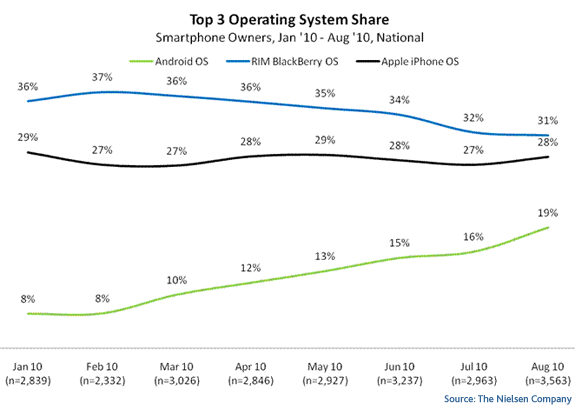
Expectations: What do your patrons want from their mobile experience? Have you asked them? If your patrons simply want information (hours, directions, descriptions of work, etc.), then a mobile website is entirely sufficient. If you are looking to provide your patrons with an interactive, one-of-a-kind mobile experience, then you’ll need an app for that.
In a recent New York Times article, Edward Rothstein took a look at a number of mobile apps developed by museums and concluded:
I have used museum apps to help me navigate museums. But I have generally felt used along the way, forced into rigid paths, looking at minimalist text bites, glimpsing possibilities while being thwarted by realities… It is best to consider all these apps flawed works in progress.
In a response to Rothstein’s article, Brooklyn Museum’s Chief Technology Officer Shelley Bernstein shared:
I had mixed feelings about the article – I mostly agree that these apps all leave much to be desired, but I disagree that we shouldn’t be trying. Experimentation without perfection is a good thing…Each and every visitor walking in our doors is likely to expect something different from an app, and every visitor is going to respond differently to what we provide. My point is that it is our responsibility, collectively, to try new approaches and provide as many entry points into content and the museum as possible.
So, mobile website or mobile app? Personally, I believe that a mobile website should be phase one in any arts organization’s mobile engagement plan. Okay, I hear you asking, “Why? Won’t the phone’s browser just show my desktop website?” The best way to answer that question is to try it.
Go ahead. Take out your phone. Go to the menu, and select the internet option. At the prompt, enter your organization’s web address. Try it on several different devices. You will quickly notice that your standard website looks unusable on every phone. The one exception to this may be an iPhone, but even it will require the user to point, pinch and slide their way to your information.
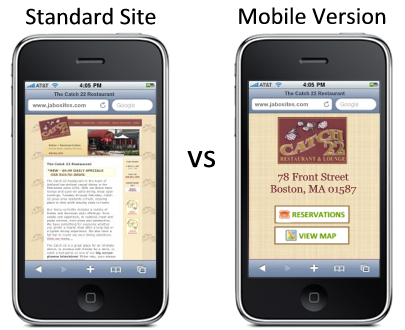
- Even if you have an iPhone, standard websites are not as easy to navigate as mobile sites.

Still not convinced that your arts organization needs a mobile website? Morgan Stanley’s global technology research team recently released a report projecting that mobile internet usage will surpass desktop internet usage in 2014. If you do not have a mobile website, then the steadily increasing number of internet users who attempt to access your information via mobile devices will get the wrong content, presented in the wrong order, with a slow and costly download, and with an ill-adapted layout.
Don’t let this happen to your patrons. Even if you do not have room in your budget for a custom-designed mobile site, there are a number of resources available for converting your current website into a mobile-friendly site.







